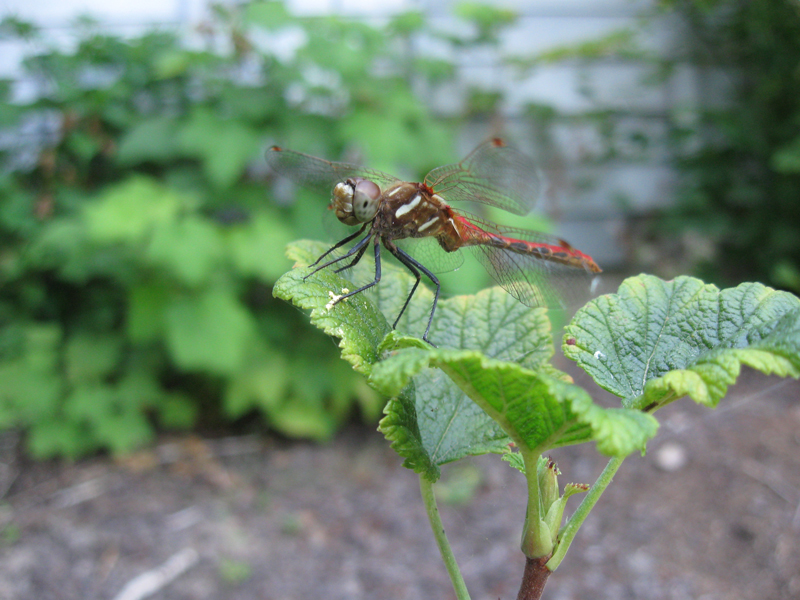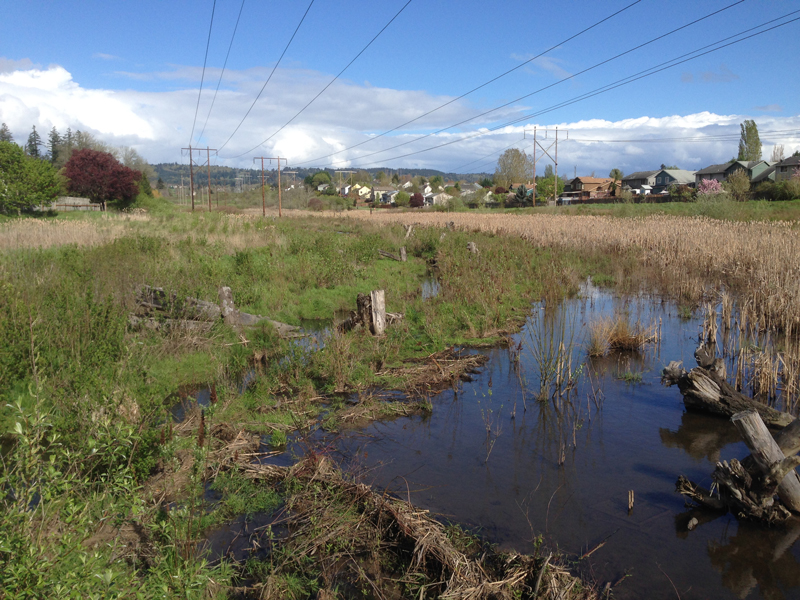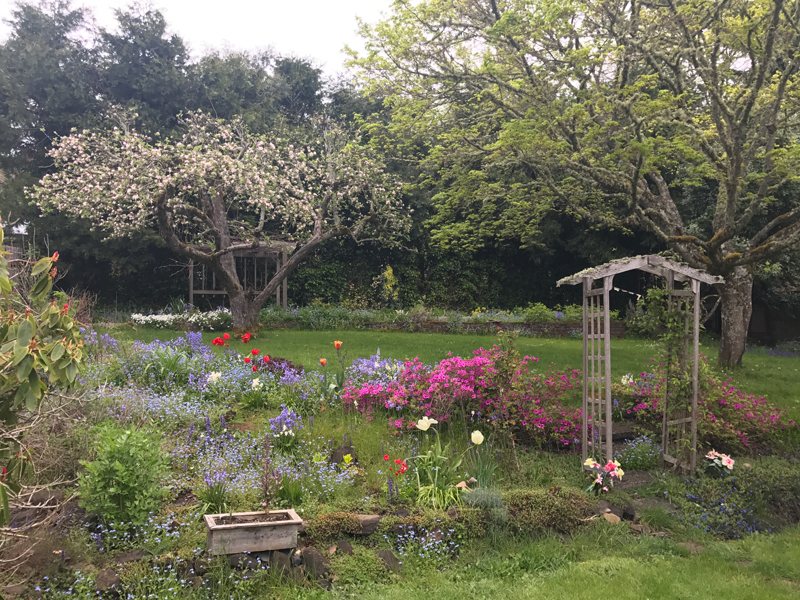This article originally appeared in our fall 2017 issue of Wings Magazine.
“Why do you have so many animals in your yard?” Curious who was speaking, I looked up from weeding to see a small boy standing on the sidewalk watching bumble bees collect pollen from the California poppies. I smiled and replied, “I created this garden for them.” He smiled back and said, “It looks like a forest.” For a person barely two feet tall, it would look like a forest. My yard has towering mock orange and red flowering currants, intermixed with yarrow, lupine, poppies, asters, herbs, and other flowers planted to attract bees and butterflies.
With his mom’s okay, Sammy began to explore my “forest.” It was a delight to watch him crawl between daylilies seeking hidden strawberries, and chase after a western tiger swallowtail (Papilio rutulus) that had been nectaring on the mock orange. Even the cabbage white butterfly (Pieris rapae) resting on a dandelion inspired squeals of joy. Yet, it was the dragonfly that most excited Sammy. His eyes grew almost as large as the dragonfly’s when I explained that it was a real live transformer, spending most of its life in water before sprouting wings to take to the air.

Sammy’s enthusiasm for the dragonfly made me realize that my garden can illustrate the connections within urban areas, especially the movement of stormwater, better than any PowerPoint presentation. The visiting dragonfly acted as an emissary for our local stream system, reminding me of how my decisions flow away from my garden and affect the larger ecosystem in which I live. The runoff from my property goes directly into Tugman Creek, which flows into the Willamette River, which provides habitat for wild salmon and drinking water for thousands of Oregonians. It ends up in the Columbia River, home to still more native fish populations, on its way to the Pacific.
Similar to the way that your house’s roof is designed to shed rain, our towns and neighborhoods have been gradually engineered so that stormwater is channeled and diverted to avoid flooding. This efficient system of moving water away from buildings also provides a conduit for the chemicals used in and around our homes to move directly into local streams, creeks, ponds, and rivers. The U.S. Geological Survey’s most recent national analysis of urban waterways found that almost every single sample of surface water contained at least one pesticide and generally two or more. When people water their gardens or summer rainstorms hit, runoff from yards carries pesticides into local streams, where they may harm aquatic life and contaminate drinking-water supplies.
Pesticides, by definition, include insecticides, herbicides, fungicides, rodenticides, and other “cides.” There are more than six hundred active ingredients registered for use in pesticides in the United States, and more than twenty-five thousand different products on the market. The chemicals in these products all have distinct characteristics, that, in part, determine risk. For example, neonicotinoid insecticides—best known for the significant risks they pose to pollinators—are hydrophilic, or water loving, and thus move readily into both surface and ground water. Most neonicotinoids are also persistent, meaning that they continue to be toxic, and thus liable to contaminate water, for weeks to months after they are applied.

Given the potential threat that neonicotinoids pose to water, the Xerces Society performed a preliminary risk assessment on imidacloprid, the oldest neonicotinoid and, until recent years, the one most widely employed. Using extensive water quality monitoring data from the California Department of Pesticide Regulation, we were able to compare the levels of imidacloprid detected in the state’s waters with the levels that cause harm to such species as caddisflies and mayflies, which, along with insects such as stoneflies and dragonflies, are vital to healthy streams. These insects are predators of any species, including mosquitoes and other pests, and are important as prey for fish and even songbirds. Because their presence is directly tied to clean water, they are also very good indicators of water quality, which is why they are used in research.
Our assessment found that current contamination levels in California can harm and even outright kill these sensitive invertebrates. The potential risks from this disruption to our aquatic systems include upsurges in pest species such as mosquitoes when predators and competitors are killed; increased methane production when microbes replace invertebrate decomposers; and declines in songbirds and fish due to the loss of their main food source.
It is often assumed that the worst pesticide pollution comes from farmland, but years of research by the U. S. Geological Survey tells us that urban and suburban pesticide application—including use on lawns, flower beds, and street trees—is also a significant source of water contamination. In fact, the highest level of imidacloprid detected in California was in urban stormwater, where it was well above the concentration that kills mayflies.
While the widespread environmental assault by neonicotinoids must be addressed, limiting or even eliminating their use won’t solve the problems of pesticide contamination. History shows that when one pesticide is removed from the market, people often just use whatever new pesticide is offered, and the unfortunate fact is that substituting one group of pesticides for another invariably leads to a new set of environmental problems. Case in point: before neonicotinoids were in wide use, pyrethroids were some of the most commonly applied insecticides in urban environments. Unlike neonicotinoids, pyrethroids are hydrophobic and do not readily dissolve in water. Instead, they are more likely to bind to soil particles. That characteristic doesn’t limit their movement into water, however; they simply move with soil particles suspended in runoff. Even though pyrethroids are generally short-lived, they can persist in sediment where the sunlight that helps break them down doesn’t penetrate. Pyrethroid contamination was so bad in California that the state completed a re-evaluation of their use that resulted in regulations restricting whether and how seventeen different pyrethroids can be used in urban areas. Neonicotinoids were presented as replacements for many urban pyrethroid uses; now these substituted chemicals are commonly found in California’s urban waters.

Even herbicides, often considered benign and frequently used in urban gardens, can be problematic. For example, 2,4-D (a common ingredient in “weed and feed” products) and some glyphosate compounds (the active ingredient in many products, including Roundup) are toxic to early life stages of freshwater mussels. These shellfish provide valuable ecological services to humans because they filter water as they eat. Unfortunately, many freshwater mussel populations are in decline or have already been lost, in part due to the presence of chemicals in the waterways in which they live.
While this may seem like a lot of bad news, understanding the risks that pesticides pose can help inform our decisions. In a home garden it can be relatively easy to avoid using them altogether, or at least to consider using them only as a last resort. Moreover, understanding the hazards can inspire us to share this information to begin healing our environment. For example, concerned about the risks of pesticides, another of my young neighbors—an eight-year-old budding entomologist—asked everyone on the block to stop using them, and to seek out garden plants that haven’t been treated with long-lived neonicotinoids. Because of his simple request, the whole block pledged to be pesticide-free. I am thrilled by this neighborhood pact, which on a small scale helps protect pollinators from being exposed to toxic substances and reduces the amount of pesticides making their way into our urban waterways. Plus, here in my yard, Sammy can crawl around and enjoy the edible plants in the garden, without being exposed to harmful chemicals.
My neighborhood is not unique. Across the country people are pledging to reduce their use of pesticides and to increase habitat for pollinators and other beneficial insects. At Xerces, we get many questions about how to make communities more pollinator-friendly, and now, thanks to several recent grants, we are newly able to expand our urban and suburban outreach efforts. This spring, Xerces’ program directors came together to discuss how best to accomplish this. We are creating a set of trainings to introduce people to the amazing diversity of native bees and butterflies found around our homes, share specific and simple ways to create healthy habitat in both yards and parks, and highlight citizen-science opportunities such as Dragonfly Pond Watch and Bumble Bee Watch.
Knowing that you, our members, have a vast array of knowledge and expertise in insect conservation, we are also excited to create a speakers bureau, which brings a train-the-trainers element to this work. This group of Xerces Society ambassadors will grow the number of people able to provide trainings and share the marvels of the insect world with new audiences.
As Sammy left that afternoon, with thyme and rosemary scrunched in his strawberry-stained hands, I imagined him joining the Xerces speakers bureau in a few years. With his infectious energy, he could easily transform a room full of individuals into an organized group of bug enthusiasts. One boy’s sense of wonder, inspired by a small urban garden, can go a long way toward saving the world.
Further Reading
Smarter Pest Management: Protecting Pollinators at Home
Scientists Urge Action to Protect Waters from Neonicotinoid Insecticides
Protecting California’s Waters from Neonicotinoid Contamination



